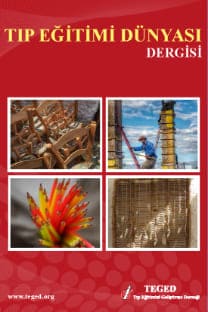Dundee Mevcut Eğitim Ortamı Değerlendirme Ölçeği (DREEM-TR): Türkçe Uyarlama Çalışması
Ölçek uyarlama, eğitim ortamı, değerlendirme, tıp, sağlık
The Dundee Ready Education Environment Measure (DREEM): Turkish Adaptation Study
Scale adaptation, educational environment, evaluation, medicine, health,
___
- 1. Gülpınar M, Yeğen B, Kalaça S. Tıp eğitimi anabilim dalları V. kış okulu sonuç raporu. Tıp Eğitimi Dünyası. 2012;35(35):16-28.
- 2. Demirören M, Palaoglu Ö, Kemahli S, Özyurda F, Ayhan IH. Perceptions of students in different phases of medical education of educational environment: Ankara University Faculty of Medicine. Medical Education Online. 2008;13:1-8.
- 3. Tripathy S, Dudani S. Students’ perception of the learning environment in a new medical college by means of the DREEM inventory. International Journal of Research in Medical Sciences. 2013;1(4):385–391.
- 4. Demiral Yılmaz N, Yalçınkaya M. Tıp öğrencilerinin öğrenme iklimi algılarının; akademik özyeterlik, hekimlik mesleğine yönelik tutum ve akademik başarı açısından incelenmesi. Tıp Eğitimi Dünyası. 2018;53:13-23. DOI: 10.25282/ted.453698
- 5. Genn JM. AMEE Medical Education Guide No. 23 (Part 2): Curriculum, environment, climate, quality and change in medical education – a unifying perspective. Medical Teacher. 2001;23(5):445-454. DOI: 10.1080/01421590120075661
- 6. Bakhshialiabad H, Bakhshi M, Hassanshahi G. Students’ perceptions of the academic learning environment in seven medical sciences courses based on DREEM. Advances in Medical Education and Practice. 2015;6:195-202. DOI: 10.2147/AMEP.S60570
- 7. Miles S, Swift L, Leinster SJ. The Dundee Ready Education Environment Measure (DREEM): A review of its adoption and use. Medical Teacher. 2013;34(9):620-634. DOI: 10.3109/0142159X.2012.668625
- 8. Soemantri D, Herrera C, Riquelme A. Measuring the educational environment in health professions studies: A systematic review. Medical Teacher. 2010;32:947–952. DOI: 10.3109/01421591003686229
- 9. Sunkad MA, Javali S, Shivapur Y, Wantamutte A. Health sciences students’ perception of the educational environment of KLE University, India as measured with the Dundee Ready Educational Environment Measure (DREEM). Journal of Educational Evaluation for Health Professions. 2015;12(37):1-4. DOI: 10.3352/jeehp.2015.12.37
- 10. Al-Ayed IH, Sheik SA. Assessment of the educational environment at the College of Medicine of King Saud University, Riyadh. Eastern Mediterranean Health Journal. 2008;14(4): 953–959.
- 11. Arzuman H, Yusoff MS, Chit SP. Big Sib students’ perceptions of the educational environment at the School of Medical Sciences, Universiti Sains Malaysia, using Dundee Ready Educational Environment Measure (DREEM) inventory. Malaysian Journal of Medical Sciences. 2010;17(3):40–47.
- 12. Mayya SS, Roff S. Students’ perceptions of educational environment: A comparison of academic achievers and under-achievers at Kasturba Medical College, India. Education for Health. 2004;17(3):280–291. DOI: 10.1080/13576280400002445
- 13. Veerapen K, McAleer S. Students’ perception of the learning environment in a distributed medical programme. Medical Education Online. 2010;15:51-68. DOI:10.3402/meo.v15i0.5168
- 14. Roff S, McAleer S. What is educational climate? Medical Teacher. 2001;23(4):333–334. https://doi.org/10.1080/01421590120063312
- 15. Roff S, McAleer S, Harden RM, Al-Qahtani M, Ahmed AU, Deza H, Groenen G, Primparyon P. Development and validation of the Dundee Ready Education Environment Measure (DREEM). Medical Teacher. 1997;19(4):295–299. DOI: 10.3109/01421599709034208
- 16. Dunn S, Burnett O. The development of a clinical learning environment scale. Journal of Advanced Nursing. 1995;22(6):1166-1173. DOI: 10.1111/j.1365-2648.1995.tb03119.x
- 17. Sarı D. Hemşirelik yüksekokulu öğrencilerinin klinik öğrenim çevrelerini değerlendirmelerinin incelenmesi (Yayınlanmamış yüksek lisans tezi). Ege Üniversitesi Sağlık Bilimleri Enstitüsü, İzmir, 2001.
- 18. Beaton DE, Bombardier C, Guillemin F, Ferraz MB. Guidelines for the process of cross-cultural adaptation of self-report measures. Spine. 2000;25(24):3186-3191.
- 19. Geisinger KF. Cross-cultural normative assessment: Translation and adaptation issues influencing the normative interpretation of assessment instruments Psychological Assessment. 1994;6(4):304-312. DOI: 10.1037//1040-3590.6.4.304
- 20. Çokluk Ö, Şekercioğlu G, Büyüköztürk S. Sosyal bilimler için çok değişkenli istatistik: SPSS ve LİSREL uygulamaları. Ankara: Pegem Akademi Yayıncılık; 2010.
- 21. Jöreskog KG, Sörbom D. LISREL 8: User’s guide. Chicago: Scientific Software; 1993.
- 22. Kline RB. Principles and practice of structural equation modeling. New York: The Guilford Press; 2011.
- 23. Tabachnick BG, Fidell, LS. Using multivariate statistics (5th ed.). New York: Allyn and Bacon; 2008.
- 24. Erkuş A. Psikolojide ölçme ve ölçek geliştirme. Ankara: Pegem Akademi Yayınları; 2012.
- 25. Nunnally JC, Bernstein IH. Psychometric theory (3rd Ed.). New York: McGraw-Hill; 1994.
- 26. Fraenkel JR, Wallend NE, Hyun HH. How to design and evaluate research in education. New York: McGraw Hill; 2012.
- 27. Pallant J. SPSS survival manual: A step by step guide to data analysis using SPSS for Windows (6th Edition). England: McGraw-Hill Education; 2016.
- 28. Boztunç Öztürk N, Eroğlu MG, Kelecioğlu H. Eğitim Alanında Yapılan Ölçek Uyarlama Makalelerinin İncelenmesi. Eğitim ve Bilim. 2015;40(178):123-137. DOI: 10.15390/EB.2015.4091
- ISSN: 1303-328X
- Yayın Aralığı: Yılda 3 Sayı
- Başlangıç: 2000
- Yayıncı: Tıp Eğitimini Geliştirme Derneği
Albena GAYEF, Bahar MARANGOZ, Şevval ŞİMŞEK, Sümeyye KAYA, Uğur Şimal ATABEY, Muzaffer ESKİOCAK
Ferdi Dırvar, Timur Yıldırım, Ömer Cengiz, Sevda Uzun Dırvar, Oytun Derya Tunç
Tıp Eğitiminde İnsani Boyut ve Anlatı Tıbbının İmkânları
Merve YILDIZ, Mehmet Ali GÜLPINAR
Berna TERZİOĞLU BEBİTOĞLU, Mehmet Ali GÜLPINAR
Ortopedi ve Travmatoloji Asistanlarının Tezleri ve Bilimsel Çalışmaları: İstanbul’da Anket Çalışması
Ferdi DIRVAR, Ömer CENGİZ, Sevda UZUN DIRVAR, Oytun Derya TUNÇ, Timur YILDIRIM
Yavuz Selim KIYAK, Özlem COŞKUN, İrem BUDAKOĞLU
Tip Fakültesi Ve Hemşirelik Fakültesi Öğrencilerinin Birlikte Öğrenme Deneyimi
Berna MUSAL, Merlinda ALUŞ TOKAT, Esin ERGÖNÜL, Serap KONAKCI, Türkan GÜNAY, Nilgün ÖZÇAKAR, Meryem ÖZTÜRK HANEY, Melike AKÇELİK
Tıp Öğrencilerinin LGBTİ+ Hastalara Yaklaşımı
Dundee Mevcut Eğitim Ortamı Değerlendirme Ölçeği (DREEM-TR): Türkçe Uyarlama Çalışması
Barış SEZER, Gülşen TAŞDELEN TEKER, Tufan Aslı SEZER, Melih ELÇİN
